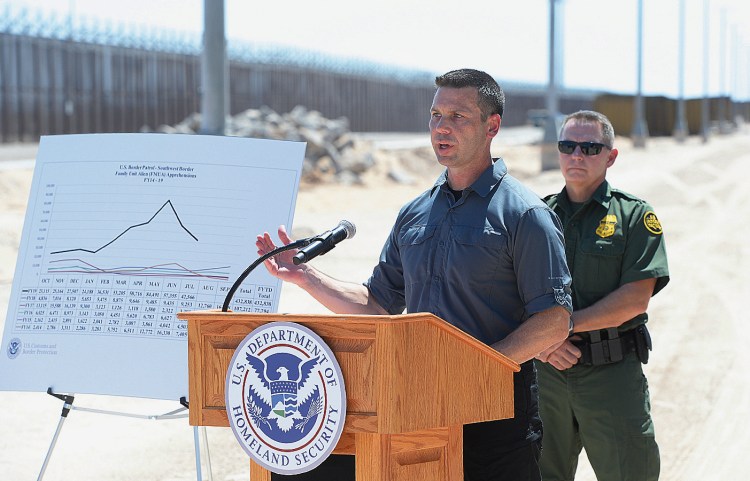Illegal crossings along the U.S.-Mexico border have fallen for a second consecutive month, fueled in part by Mexico’s crackdown on Central American migration aimed at interdicting people before they reach the United States, Department of Homeland Security officials said Thursday.
U.S. Customs and Border Protection saw its number of apprehensions drop 21 percent in July, to 82,000, the first time in five months that apprehensions have dipped below 100,000. Acting U.S. Customs and Border Protection Commissioner Mark Morgan said the drop from May to July was 43 percent, down from a recent high of more than 144,000 in May.
Morgan said the situation at the border – with a large influx of migrants, many from impoverished Central American countries – is still “in full-blown crisis.” Because of the crush, authorities continue to use temporary shelters to hold migrants immediately after they are taken into custody, and July’s apprehension totals were still more than double what they were the previous July.
The summer months usually see downturns in migration trends because of the searing heat and the accompanying dangers of crossing the Mexican desert. But Morgan said the drop is “unequivocally not the result of seasonal trends,” noting that the decline from May to July this year far exceeds the seasonal drop seen during the past five years, which he said averaged 9 percent.
Instead, U.S. officials have credited several immigration approaches for the drop, notably Mexico’s cooperation – under threat of tariffs – in stopping migrants before they reach the U.S. border and other policies aimed at deterring migrants from attempting the journey.
“Mexico has deployed almost 26,000 troops,” more than half of whom are working to interdict migrants along the U.S. border, Morgan said. “Mexico has apprehended almost 130,000 migrants this year to date. That’s almost double what they had a year before. And those efforts have been in the immediate wake of the June 7 tariff negotiations.”
The United States has also focused on tamping down asylum claims, pushing some asylum seekers back into Mexican cities to await immigration court hearings and entering into an agreement with Guatemala that will allow U.S. authorities to send some asylum seekers there. Morgan said Guatemala has yet to ratify the agreement, and that it was still unclear when authorities would be able to begin deporting asylum seekers to Guatemala.
President Donald Trump used tariff threats to force the deals with both Mexico and Guatemala. Guatemala in July agreed to accept Honduran and Salvadoran asylum seekers deported by the United States, essentially forcing those seeking refuge from those countries to begin the asylum process from the U.S. border.
Trump, who has made immigration policy a top priority for his administration, monitors the monthly numbers as an indication of whether his efforts to deter Central American migration are working, and he has erupted at Homeland Security officials in frustration when seeing the record highs.
Both Morgan and Acting Homeland Security Secretary Kevin McAleenan, who on Thursday toured a new tent facility to hold migrants in Yuma, Arizona, emphasized the president’s accomplishments in describing the migration decline.
“Thanks to President Trump’s engagement and energy, Mexico and Guatemala, along with several other Central American countries, have begun to take shared responsibility for the irregular migration flows that have become a regional crisis,” McAleenan said Thursday, according to prepared remarks.
It is unclear how long Mexico can keep up the enforcement wave, and should normal migration trends hold, a rise would likely follow the summer decline.
Morgan said a $4.5 billion emergency border aid package approved by Congress in June allowed CBP to provide its detainees with better quality care, including expanded medical services, showers and hot meals, while also enabling the faster transfer of migrant detainees out of Border Patrol stations and into other agencies’ custody.
But the aid package, along with Mexican and Guatemalan cooperation, were “still not a sustainable, durable solution to this crisis,” Morgan said, urging legislative action to change immigration law. “These are short- and mid-term solutions. These are non-sustainable. These are not directed at the root cause of what’s going on right now.”
Central American families and unaccompanied children, for whom U.S. law provides special protections, have constituted the majority of border apprehensions in recent months, presenting an additional strain on Homeland Security resources, officials say.
The administration has argued that existing protections for migrant children and families, particularly in hindering their swift deportation, places an undue burden on CBP.
The decline this summer included a more than 50 percent drop in the apprehensions of families and unaccompanied children, Morgan said. Even then, they still accounted for 67 percent of all border arrests, and border authorities still apprehended 360 percent more families than they had the previous July, he said.
Copy the Story Link
Send questions/comments to the editors.



Success. Please wait for the page to reload. If the page does not reload within 5 seconds, please refresh the page.
Enter your email and password to access comments.
Hi, to comment on stories you must . This profile is in addition to your subscription and website login.
Already have a commenting profile? .
Invalid username/password.
Please check your email to confirm and complete your registration.
Only subscribers are eligible to post comments. Please subscribe or login first for digital access. Here’s why.
Use the form below to reset your password. When you've submitted your account email, we will send an email with a reset code.